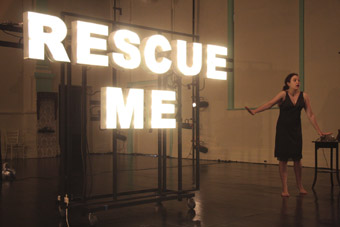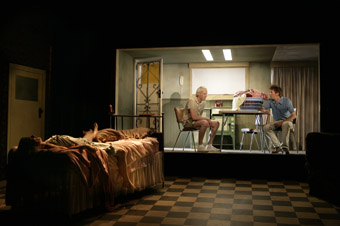dangerous stuff
john bailey: nicola gunn, four larks, mtc, malthouse

Nicola Gunn, At the Sans Hotel
photo Daisy Noyes
Nicola Gunn, At the Sans Hotel
ONE OF THE PHRASES THAT ALL TOO OFTEN OCCASIONS ME TO SLUMP-SHOULDERED DISAPPOINTMENT IS ANYTHING CALLING FOR A “NEED FOR MORE DIALOGUE.” NOT THAT DIALOGUE PER SE IS A BAD THING—I’D BE A PRETTY BLINKERED THEATREGOER IF THAT WAS MY STANCE. BUT WHEN IT COMES TO DISCUSSIONS WITHIN THE ARTS COMMUNITY, THE “NEED FOR MORE DIALOGUE” IS UP THERE WITH THE “NEED FOR MORE EDUCATION” AND “AGREEING TO DISAGREE.” IT’S A STATEMENT THAT, IN APPEARING TO COMMENCE A CONVERSATION, MORE FREQUENTLY ENDS ONE. WE NEED TO TALK MORE; LET’S END OUR TALK AT THAT.
What happens when a work of performance presents its own internal dialogue? Does it end in the same silence, shutting out its audience by subsuming their role as interlocuter into the work itself? A range of recent productions in Melbourne raised this very question, offering scenarios which weren’t simply open to interpretation but invited conflicting, even incommensurable readings.
at the sans hotel
The self-interrogation of Nicola Gunn’s At the Sans Hotel began the moment it registered in a potential audience member’s consciousness, though this wasn’t made explicit until the performance itself began. Advance publicity was strewn with enigmatic images of a half-visible Gunn disguised as a noir femme fatale or a monkey bellhop; textual fragments mentioned a woman trapped in a bathtub or lost in a desert.
What we got was something quite other. A woman with a slightly hokey French accent greets her audience and hands out an invisible questionnaire, inviting us to complete a survey on our experience of the (non-)show so far. Okay, we’re playing pretend. Then we’re given real pencils to use in the process. Is this some kind of joke?
The French woman eventually apologises that Nicola Gunn’s At the Sans Hotel won’t be on offer tonight. She instead takes us on an hilarious, sometimes desperate series of digressions in which she discusses the show that should have taken place and the narrative problems it presented. A chalkboard breakdown of structure, themes, metaphors and sources recreates the absent play, and frequent audience involvement is less threatening than engaging. Gunn—and I was never even sure if this was Gunn we were watching—is a brilliantly likeable performer who effortlessly wins over her onlookers within minutes.
It’s this charm that makes At the Sans Hotel such a success. Like UK company Hoipolloi’s exquisite Floating of last year, and with hints of Forced Entertainment’s more accessible work, this is a gift to its audience rather than a challenge. It’s not a navel-gazing exercise into meta-theatre but a bracing, bewitching investigation into presence and absence. Its real subject, which we approach in a curious crabwalk, is the identity unable to step outside of or contain itself. The open nature of the piece is a structural component of this: referring to Gunn’s earlier works, directly engaging the audience, and the whole artifice of that advance media blitz are figurations of the subject that cannot remain for itself a stable and coherent self. That Gunn was inspired by the case of Cornelia Rau, the schizophrenic German citizen and Australian permanent resident, whose identity breakdown made headlines in 2004, helps explain the motivation behind the work’s unique structure, but there is so much more for each viewer to discover for themselves.
the fate of franklin
Just as generous, though with a rougher polish, was Four Larks Theatre’s The Fate of Franklin and his Gallant Crew. Inspired by an ill-fated attempt to discover the fabled Northwest Passage in the 1840s, its junkyard aesthetic was a visual delight of antiquated seafaring miscellany and lush costuming (not to mention a huge band sawing away on old-timey instruments). But all of this quickly began to feel like empty nostalgia, not for its ostensible historical base but for the exciting narratives of exploration and disaster that filled many a pulp novel and popular rag of the era. Was this just an excuse to play dress-ups and spout period-sounding jargon?
As it turns out, no. My vague disquiet was eventually turned on its head as various characters began to wrest control of the narrative from each other, presenting conflicting versions of the voyage’s outcome. Each proved to have a vested interest in our interpretation of events, and this tussle put to its audience an implicit question: whom do you trust? And, more importantly, why? Is the more thrilling story (brave explorers descending into cannibal savagery) simply more interesting than the possibility that a bunch of men starved or froze to death in an anonymous landscape?
lady grey
US playwright Will Eno is known for his more brutal affronts to his audience. His Thom Pain (based on nothing) is a tour-de-force solo that works up a mystery of childhood trauma by enacting an angry performance of verbal assault on spectators. His lesser-known Lady Grey is a similarly obtuse affair that turns that violence inwards. The eponymous figure is in fact several identities occupying the same mental and physical space—dressed in an historical ballgown, Lady Grey is resolutely contemporary. She tells stories of a girl who may be her younger self, or addresses the audience directly but in a prepared fashion. Seeming spontaneity is revealed as simply another theatrical convention—we’re seeing a character playing a real performer playing a character. It’s a hugely difficult piece, as much concerned with its own inadequacies as At the Sans Hotel or The Fate of Franklin. But like those works, this anxious internal equivocating doesn’t come at the expense of understanding, but in its service.

Furious Mattress, Malthouse Theatre
photo Jeff Busby
Furious Mattress, Malthouse Theatre
furious mattress
And then there’s what may turn out to be the most baffling, bizarre production of 2010. Malthouse Theatre’s Furious Mattress left audiences reeling, uncertain whether they’d witnessed a work of genius or a complete creative car wreck. Its credentials were unimpeachable—scripted by Melissa Reeves, directed by Tim Maddock, and featuring a varied but uniformly accomplished cast. The work was spun from a notorious Victorian case in which a schizophrenic middle-aged woman was killed during a lengthy, tortuous ‘exorcism’ in a rural district. Faith, fear, ignorance and the sundry madnesses of the individual and the crowd suggested themselves as possible concerns here, but as the piece unfolded it flung possibilities far more horrifying in its audience’s faces.
The first half was, for the most part, a grinding portrait of fundamentalists unable to confront the murder they had just committed. Banal rituals of domesticity and small talk were interrupted by unsettling evocations of belief in the supernatural. The point seemed blindingly obvious: religious devotion taken to its extremes had led to a fatal outcome, and these inhabitants of a lunatic fringe were both monsters and victims of their own delusions.
Once the plot shifted to the days leading up to the killing, however, the production shifted gears like a trucker topping a mountain rise. The delusions suddenly became reality, as muted performances gave way to hysteria and histrionics and a general atmosphere of realism was upended by carnivalesque comedy. A giant pantomime rat, an exorcist straight out of Kath & Kim and the ultimate arrival of the animated mattress—more wacky than furious—provoked laughter where we might have expected chills. Serious, even earnest dialogue was met with comically delivered ripostes; at times, it felt as if four or five productions had been mashed together without explanation.
The lack of internal logic displayed by Furious Mattress provided one of those rare moments in which the old intentional fallacy was less a philosophical argument than an unquestionable fact. There was no seeking recourse in program notes to define what this production was ‘supposed’ to be, since they only confused matters more. What we were left with was less a dialogue between the work’s contrasting elements than an irresolvable battle between those same aspects. This wasn’t the dialectic process of self-reflexive theatre, in which the apparent clash of elements results in richer, hybrid new formations—it was a fight where none could escape unscathed, least of all the audience. Dangerous stuff. I’d see it again.
At the Sans Hotel, created and performed by Nicola Gunn, design Nicola Gunn, Gwendolyna Holmberg-Gilchrist, Rebecca Etchell, sound Luke Paulding; Theatre Works, St Kilda, Mar 16-27; Four Larks Theatre, The Fate of Franklin and his Gallant Crew, text Marcel Dorney and Four Larks Theatre, direction Jesse Rasmussen, Mat Sweeney, Sebastian Peters-Lazaro, performers Justine Campbell, Shane Mills, Caitlin Valentine, Marcel Dorney, Zak Ateka, Bonnie Taylor, Max Baumgarden, Hugo Farrant, Paul Goddard, Reuben Liversidge, Fingal Oakenleaf, Ivan Smith, Genevieve Fry, Esala Liyonage, Greg Craske, Kristian Rasmussen, Sebastian Peters-Lazaro, Jesse Rasmussen, Mat Sweeney, design Ellen Strasser, Sebastian Peters-Lazaro, lighting Geordie Barker, Secret location, Northcote, Mar 12-27; Melbourne Theatre Company, Lady Grey, writer Will Eno, director Julian Meyrick, performer Tanya Burne, lighting Casey Norton, Lawler Studio, MTC, Feb 19-30; Malthouse Theatre, Furious Mattress, writer Melissa Reeves, director Tim Maddock, performers Rita Kalnejais, Kate Kendall, Robert Menzies, Thomas Wright, design Anna Cordingley, lighting Paul Jackson, sound & music Jethro Woodward, Beckett Theatre, Malthouse, Feb 19-Mar 13
RealTime issue #96 April-May 2010 pg. 38






